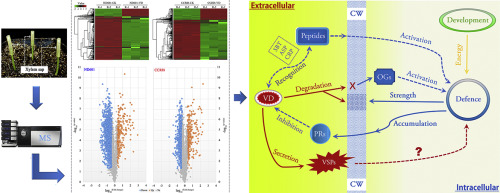当前位置:
X-MOL 学术
›
J. Proteomics
›
论文详情
Our official English website, www.x-mol.net, welcomes your
feedback! (Note: you will need to create a separate account there.)
Proteomic analyses on xylem sap provides insights into the defense response of Gossypium hirsutum against Verticillium dahliae.
Journal of Proteomics ( IF 2.8 ) Pub Date : 2019-12-03 , DOI: 10.1016/j.jprot.2019.103599 Jun Yang 1 , Xingfen Wang 1 , Meixia Xie 1 , Guoning Wang 1 , Zhikun Li 1 , Yan Zhang 1 , Liqiang Wu 1 , Guiyin Zhang 1 , Zhiying Ma 1
Journal of Proteomics ( IF 2.8 ) Pub Date : 2019-12-03 , DOI: 10.1016/j.jprot.2019.103599 Jun Yang 1 , Xingfen Wang 1 , Meixia Xie 1 , Guoning Wang 1 , Zhikun Li 1 , Yan Zhang 1 , Liqiang Wu 1 , Guiyin Zhang 1 , Zhiying Ma 1
Affiliation

|
Verticillium dahliae seriously affects the yield of cotton. Here, V. dahliae infection induced the significant reduction of protein concentration in cotton xylem sap (CXS), suggesting that the protein composition have changed. Thus, the proteomics in CXS from resistant Gossypium hirsutum cv. ND601 and susceptible CCRI8 infected by V. dahliae were analyzed using the label-free method. A total of 3047 proteins were identified across all four CXS sample groups. 1717 and 1476 proteins were differentially accumulated in ND601 and CCRI8 after infection with V. dahliae, respectively. The majority of up-accumulated and induced proteins belongs to pathogenesis-related proteins and associates with cell wall (CWRPs). Down-accumulated and disappeared proteins were principally related to plant growth and development. Differentially accumulated CWRPs from ND601 and CCRI8 in type and quantity were not entirely consistent with each other, leading to different cell wall dynamics and strength, which were partly proved by the measurement of stem mechanical strength. Most of proteins related to growth and development were down-accumulated in ND601 compared to CCRI8, suggesting that the resistant variety may transfer more energy for defense responses or reduce nutrient acquisition of V. dahliae for colonization more effectively than the susceptible. SIGNIFICANCE: Verticillium wilt, mainly caused by V. dahliae, is one of the most destructive diseases in cotton. V. dahliae usually penetrates the root epidermis, reaches vascular tissues, and eventually extends to the above-ground tissues along the xylem vessels. Obviously, xylem is an important battlefront for plant defense to V. dahliae. Therefore, we analyzed the proteome profiles of xylem saps from resistant and susceptible cotton cultivars. Our findings provide valuable insights into the molecular mechanism underlying the interaction between V. dahliae and cotton.
更新日期:2019-12-04











































 京公网安备 11010802027423号
京公网安备 11010802027423号